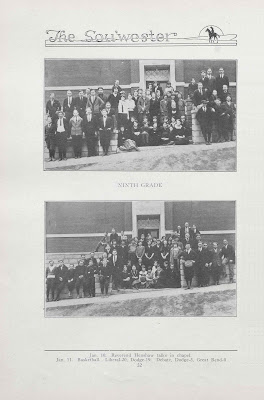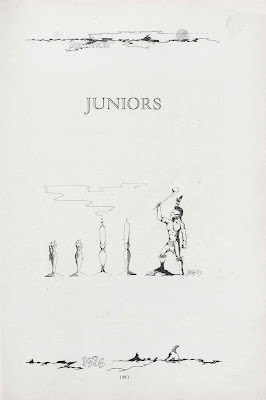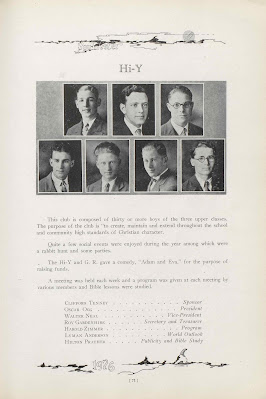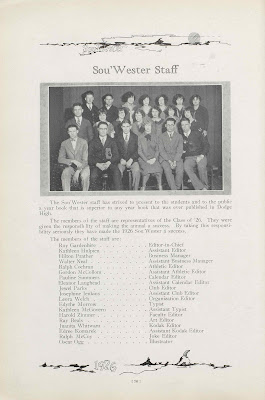Oscar John Ogg was born on December 13, 1908, in Richmond, Virginia, according to his birth certificate at Ancestry.com. His parents were Oscar Jesse Ogg and Marcie Edna Chappell. Ogg’s father worked for the Denver and Rio Grande Railroad (D & RG RR).
The 1910 U.S. Federal Census recorded Ogg, his parents and older brother, Frank, and sister, Virginia, in Salida, Colorado at 601 E Street. Ogg’s father was a superintendent at the D & RG RR.
The 1920 census said the Ogg family added another child, Robert, to the household. They resided in Albuquerque, New Mexico at 223 West Central. A few years later the Oggs moved.
Ogg was a student at the Dodge City, Kansas Junior and Senior High School. He was in the class of 1927 and staff cartoonist on the yearbook, The Sou’wester, beginning in 1924.
In 1925 Ogg was yearbook staff cartoonist, sophomore class president, Honor Society member, Hi-Y vice-president, and Sodalitas Latina member.
The 1926 yearbook said Ogg was the staff illustrator, bass in the Boys’ Glee Club, performer in the Junior class play, Hi-Y president, and Honor Society member.
Ogg’s senior year activities were noted in the 1927 Sou’wester. He was the yearbook editor-in-chief and staff illustrator, football quarterback, Student Council member, school newspaper Dodger editor-in-chief, Hi-Y president, Boys’ Glee Club first tenor, and Quill and Scroll member.
Ogg was in the class of 1931 and an architecture major at the University of Illinois in Urbana Champaign. In 1932 he received a Bachelor of Science degree in Architecture.
While at school, Ogg was in contact with his cousin, Warren Chappell, an illustrator and lettering artist. In Something About the Author (1990) Chappell explained how he and Ogg moved to New York.
New York in the spring of 1932 was an unlikely place to set up shop as a graphic artist. First we needed to visit our families and this we could do while sorting out our alternatives. My cousin, Oscar Ogg, who was graduating in architecture from the University of Illinois, wrote that he wanted to do what I was doing rather than practice his profession. We decided that Lydia would remain in Virginia while Oscar and I went to New York to establish a base. It was the summer of Franklin Roosevelt’s nomination. After almost six months, we had our things out of storage and into an apartment at 22 West 54th Street, later to become the interim site of the Whitney Museum. Oscar lived with us for a period while I could share with him some of my experiences with letter forms and introduce him to Huxley House, the outstanding type composition house where he would work for several years. ...
Who’s Who in Graphic Art (1962) said
…From 1932 to 1935 he worked as a typographer and then took a position as art director in an advertising agency until 1937. Following this he became a freelance designer, lettering artist and calligrapher …
The New York Times, August 11, 1971, said Ogg “studied layout and typography with Walter Huxley in New York and was an assistant to Boardman Robinson at the Colorado Springs Fine Arts Center.”
Art Digest, March 15, 1939
The Times said
When Mr. Ogg was first working as a calligrapher in New York, providing lettering and jacket designs for book covers, he found himself at a disadvantage because of his youth. To compete more effectively, he grew a red beard since beards were then considered a symbol of age.
Ogg also freelanced as an illustrator. Loring & Mussey published Chappell’s The Anatomy of Lettering in 1935. Chappell may have recommended his cousin, Ogg, to the publisher who used Ogg to illustrate The Knights at Bay, also released in 1935. The following year, Ogg did the jacket art, and probably the lettering, for Chinatown Inside Out; he signed it in the lower left corner.
On June 12, 1934, Ogg married Margarita Westenberger at Blessed Sacrament, Springfield, Illinois.
In the 1940 census, Ogg and his wife lived at 100 West Fifty-Fifth Street. He was an independent calligrapher. Six months later on October 24, 1940, Ogg signed his World War II draft card. He was self-employed and lived at 228 West 72nd Street in Manhattan. Ogg’s description was five feet nine inches, 140 pounds, with blue eyes and brown hair. Who’s Who said Ogg served in the U.S. Army with the Graphic Division, Corps of Engineers, and with Army Intelligence, Washington, D.C.
Ogg’s An Alphabet Source Book was published in 1940 by Harper and Bros. Thomas Y. Crowell published his next book, The 26 Letters, in 1948.
The 1944 Manhattan, New York City directory listed the same 1940 census address. The 1948 and 1949 directories said Ogg resided in Jackson Heights, Queens at 34-06 81st Street. By 1951, Ogg made his home in Stamford, Connecticut. The city directory said his address was Lone Close Road near Westover Road. His occupation was an executive.
In 1946 Ogg established the School of Calligraphy at Columbia University and began work at Book-of-the-Month Club. A 1950 issue of American Printer said
Book-of-the-Month Club has announced that Harry N. Abrams, advertising manager of the club, plans to resign early this year to launch his own publishing concern which will specialize in the publishing of art books. He will remain associated with the Book-of-the-Month Club as a member of the board of directors and a consultant. Oscar Ogg, present art director of the club, will succeed him as advertising manager. …
Ogg designed alphabets for Photo-Lettering, Inc. in New York: Oscar Ogg Folio, Oscar Ogg Roman 3, Oscar Ogg Italic, Oscar Ogg Roman 4, Oscar Ogg Italic 4, Oscar Ogg Semi Uncial, and Oscar Ogg Irish Uncial. The alphabets appeared in the Alphabet Thesaurus 9000 (1960).
Ogg passed away on August 19, 1971, in Stamford, Connecticut, according to the Connecticut Death Index at Ancestry.com.
Works by Oscar Ogg
Advertising Arts
November 1933
Illustrations
The Knights at Bay
Philip Lindsay
Loring & Mussey, 1935
Illustrations
Chinatown Inside Out
Leong Gor Yun
Barrows Mussey, 1936
Jacket illustration and lettering
Green One
Lelia Brodersen
Barrows Mussey, 1936
Illustrations
Sergeant Death
Frank P. Grady
Loring & Mussey, 1936
Jacket design
Charles Franklin Lender
Thomas Y. Crowell, 1937
Illustrations
An Alphabet Source Book
Oscar Ogg
Harper & Bros., 1940
The Anatomy of Sea Power
Arthur J. Marder
Alfred A. Knopf, 1940
Binding design
May Lamberton Becker
Dodd, Mead & Company, 1940
Illustrations
America Was Like This
Emma Gelders Sterne
Dodd, Mead & Company, 1941
Illustrations
La Jeunesse de Cyrano de Bergerac
Henry de Gorsse, Joseph Jacquin, Joseph Franz Freiherr von Jacquin
Edited by Alexander D. Gibson
Illustrated by by Rafaello Busoni
Harper & Brothers, 1941
Binding design
Meet the South Americans
Carl Crow
Harper & Brothers, 1941
Illustrations
Art for All Art: Appreciation As Related to Dress, Home, School, and Work
Francis Grant Bartlett & Claude C. Crawford
Harper & Brothers Publishers, 1942
Illustrations
Franklin Street
Philip Goodman
Alfred A. Knopf, 1942
Binding design
The Mask Book
Howell, Soskin, Publishers, Inc., 1942
Illustrations
Mr. Lincoln’s Funnybone: Wherein the White House Joker Retells His Best Yarns & Fables
Edited by Loyd Dunning
Howell, Soskin, 1942
Illustrations
The Raft
Robert Trumbull
Henry Holt & Co., 1942
Jacket design
Frank Crowninshield
Julian Messner, Inc., 1942
Typography and design
Design and Paper, Number 11, c1943, Lettering for Commerce
The Holy Bible
The Illustrated Modern Library
Random House, 1943
Book design
Kate Fennigate
Booth Tarkington
Doubleday Doran, 1943
Jacket design
Life With Father and Mother
Clarence Cay
Alfred A. Knopf, 1943
Jacket design
Man in Structure and Function
Fritz Kahn, M.D.
Alfred A. Knopf, 1943
Slipcase design
Prairie Chautauqua
Lucile P. Fargo
Dodd, Mead & Co., 1943
Illustrations
Sir Walter Scott
Dodd, 1943
Jacket and decorations
Theodore Roosevelt: Strenuous American
Alvin Fay Harlow
J. Messner, 1943
Illustrations
Print, Volume 3, Number 3, 1943
Let Our Hearts Be Stout
Franklin Delano Roosevelt
1944
Design and calligraphy
American Artist, September 1944, Oscar Ogg Calligrapher
Inland Printer, October 1944, Calligraphy’s Flowering, Decay & Restoration
Our Sons Will Triumph
Jack Dixon
Thomas Y. Crowell Co., 1945
Lettering and decorations
Print, Fall 1945, Volume 3, Number 4, Lettering & Calligraphy
The Happy Profession
Sedgwick, Ellery
Little, Brown, 1946
Jacket design
House Above the River.
Michael Foster
Little, Brown & Company, 1946
Jacket design
The River
Ruth Godden
Little Brown, Boston, 1946
Jacket design
The Queen’s Awards 1946
Ellery Queen
Little, Brown & Co., 1946
Jacket design
Oscar Ogg
Dover, 1947
Great Morning!
Osbert Sitwell
Little, Brown and Company, 1947
Jacket design
Ernie Pyle
William Sloane Associates, 1947
Jacket design
The Left Hand Is the Dreamer
Nancy Wilson Ross,
Sloane, 1947
Jacket design
Edited by Saxe Commins & Robert N. Linscott
Random House, 1947
Book design
Edited by Saxe Commins & Robert N. Linscott
Random House, 1947
Book design
Man Against Myth
Barrows Dunham
Little, Brown & Company, Inc., 1947
Jacket design
Mountain Time
Bernard De Voto
Little Brown, Boston, 1947
Jacket design
The Queen’s Awards 1947
Ellery Queen
Little, Brown & Co., 1947
Jacket design
Three Short Novels By Vercors
Jean Bruller Vercors
Little, Brown & Co., 1947
Illustrations
Treasure Island
Robert Louis Stevenson
Grosset & Dunlap, 1947
Book design
Macmillan Company, 1947
Book design
American Artist, May 1947, A Comparison of calligraphy and lettering
The 26 Letters
Oscar Ogg
Thomas Y. Crowell Company, 1948
The Dispossessed
John Berryman
William Sloane Associates, Inc., 1948
Jacket design
Edwin Arlington Robinson
Emery Neff
William Sloane Associates, 1948
Jacket design
Margaret Sidney
Grosset & Dunlap, 1948
Book designed
Rudyard Kipling
Doubleday & Company, Inc., 1948
Book design
Robert Louis Stevenson
Grosset & Dunlap, 1948
Book design
Laughter in the Next Room
Sir Osbert Sitwell
Little, Brown and Co., 1948
Illustrations
The Queen’s Awards 1948
Ellery Queen
Little, Brown & Co., 1948
Jacket design
Road to Survival
William Vogt
William Sloane Associates, 1948
Jacket design
Artifacts ’48
Bruce McClellan
Maple Press Company, 1949
Calligraphy
Norman Auth
William Sloane Associates, 1949
Jacket design
The Empire and the Glory: Napoleon Bonaparte 1800–1806
Fletcher Pratt
William Sloane, 1949
Jacket design
Lettering as a Book Art
Oscar Ogg
George McKibbin & Son, 1949
(selected pages below)
Books and Printing: A Treasury for Typophiles
Edited by Paul A. Bennett
World Publishing Co., 1951
article
Howard Pyle
Grosset & Dunlap, 1952
Book design
Three Classics of Italian Calligraphy. Arrighi, Tagliente and Palatino
With an introduction by Oscar Ogg
Dover Publications, 1953
Europe: A Journey with Pictures
Anne Freemantle and Bryan Holme
Studio Publications, 1954
Typography
Modern Prints & Drawings: A Guide to a Better understanding of Modern Draughtsmanship
Paul J. Sachs
Alfred A. Knopf, 1954
Book and binding design
Sixty-three Drawings by Warren Chappell
Typophiles, 1955
Book design
Art in America, No. 4 1959, Calligraphy
Elizabethan Lyrics from the Original Texts
Norman Ault, Editor
Capricorn Books, 1960
Cover design
Oscar Ogg
Thomas Y. Crowell Company, 1961
Seventh Printing
Girl From Fitchburg
Bernardine Kielty Scherman,
Random House, 1964
Jacket design
Oscar Ogg
Thomas Y. Crowell Company, 1971
Revised Edition
Further Reading and Viewing
Related Posts
(Next post on Monday: Jon D'Agostino, Colorist, Artist, Inker and Letterer)
















































































































Hi! Thanks for publishing such an extensive piece about Ogg. I'm wondering if I could ask you some questions about him for a research paper I'm writing. Could you send me an email? theodore@sharptype.co
ReplyDelete